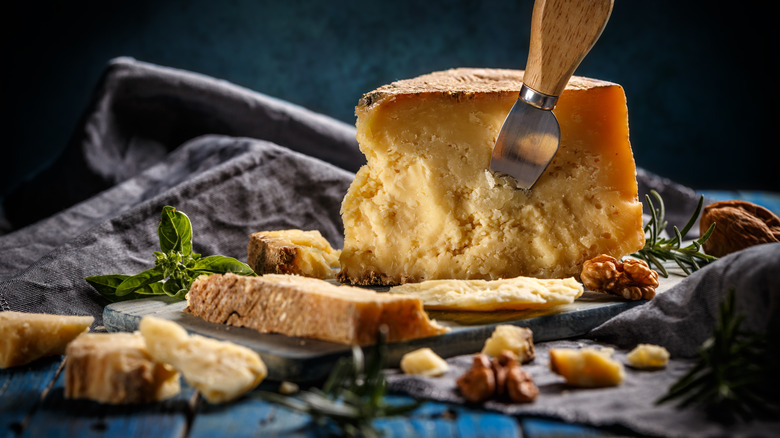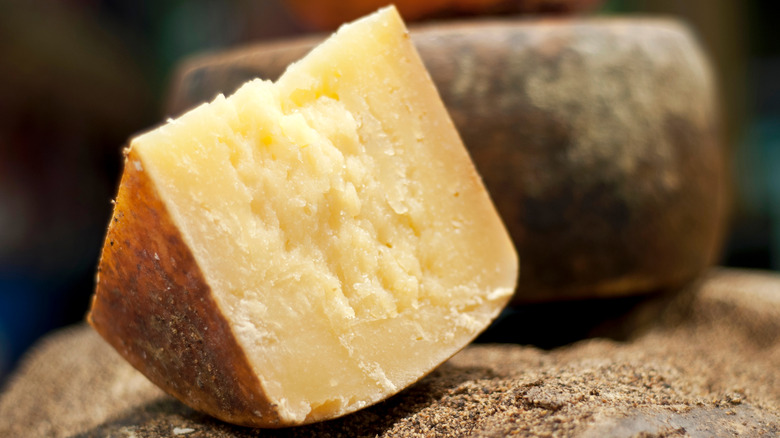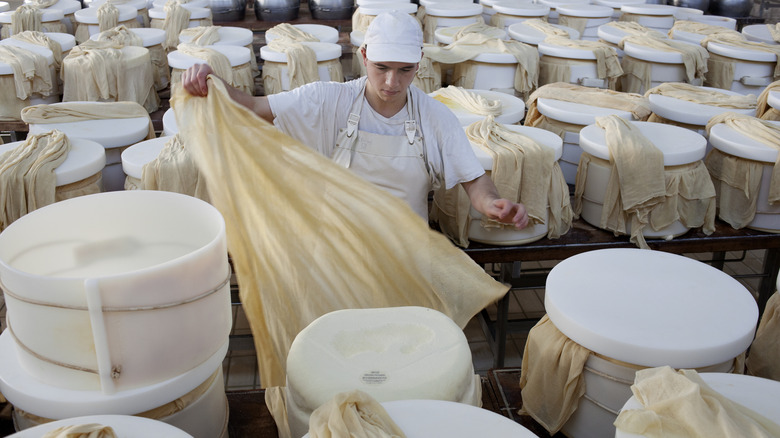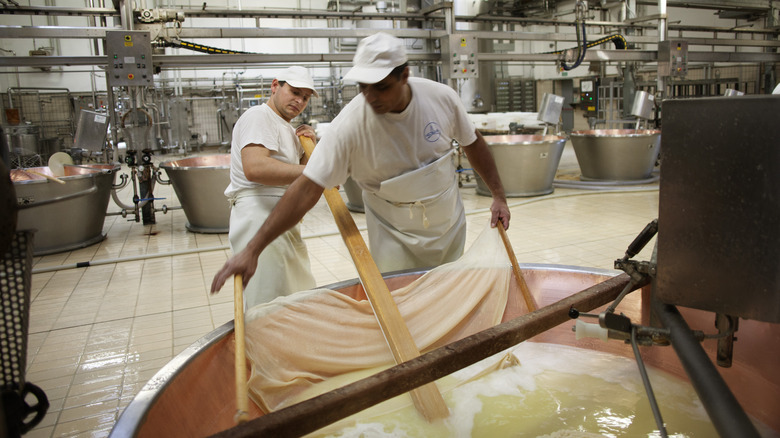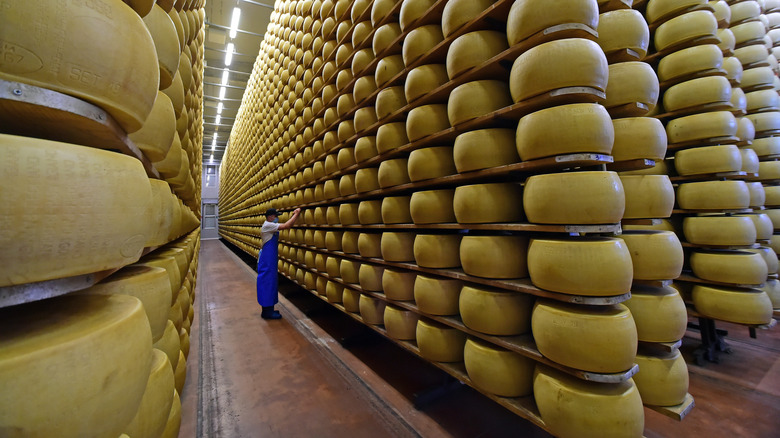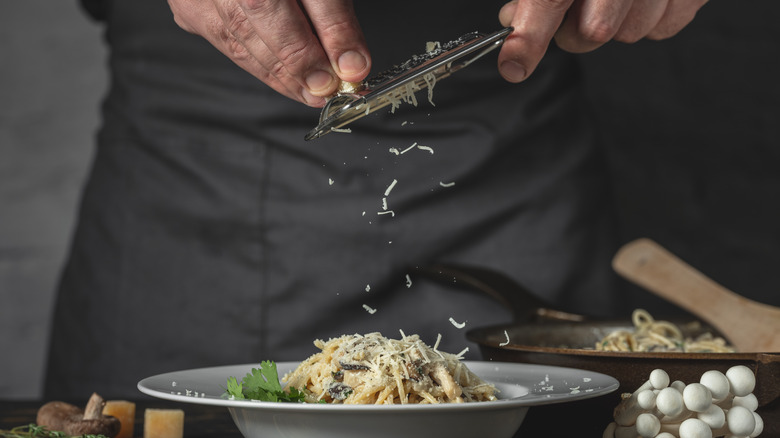What Is Grana Padano Cheese And How Is It Used?
When people think of giant wheels of Italian cheese, Parmesan is most likely the first one that comes to mind. For any Italian, on the other hand, it would probably be Grana Padano instead. In fact "MasterChef" judge Joe Bastianich refers to it as "everyday cheese," because it's the staple of every Italian kitchen. It all comes down to its versatility and the variety of recipes and ways in which it can be eaten. According to Grana Padano's official website, the cheese's flavor and texture is so unique that only Grana Padano made in the Pianura Padano regions of Italy, under the exact standards set by the Italian Ministry of Agriculture, is allowed to be sold under the name Grana Padano. Any other deviation from this standard, and it would simply be called artisanal cheese or aged cheese, like how Champagne can only be called as such if produced in the Champagne region of France.
Though Grana Padano looks almost identical to Parmesan, Parmesan isn't held to the same quality standard unless it's specified as Parmigiano-Reggiano DOP, which is why you can find pre-grated Parmesan in the pasta aisle, but you won't find authentic Grana Padano. If you're looking for high-quality aged Italian cheese, Grana Padano is your best bet.
What is Grana Padano?
Grana Padano is exactly what it's name says it is. In Italian, "grana" means grainy, and "padano" means from Pianura Padano. In other words, Grana Padano is grainy cheese produced in the Pianura Padano regions of Northern Italy, mainly Piedmont, Lombardy, and Veneto.
The grainy texture of Grana Padano is due to "crystalline spots of an amino acid called tyrosine, which give the paste an extra crunch," Culture Cheese Magazine explained. These cheese crystals form during a crucial stage of the production process, which ultimately results in a hard, pale-colored cheese with a thick rind. In the same way that holes are characteristic of Swiss cheese, and mold is characteristic of bleu cheese, this granular texture is one of the defining characteristics of Grana Padano. After molding, seasoning, drying, and undergoing a 9-month maturation process, Grana Padano develops its signature flavor profile, which is sweet, slightly fruity with warm notes of caramel and butterscotch, This combination of flavors and textures makes Grana Padano perfect to grate, pair with wine, eat with antipasti, or serve on its own.
How is Grana Padano made?
As demonstrated by the Grana Padano Protection Consortium, the perfect Grana Padano starts with fresh, partially-skimmed, raw milk, which is combined with natural whey and rennet in large copper cauldrons. The resulting curds are broken down by hand with a "spino," essentially a giant whisk, then left for one hour until they settle at the bottom of the copper cauldron. The curd is carefully extracted, again by hand, and put into two sets of wheel-shaped molds for 24 hours each. After the molding period, the wheels are immersed in brine for two weeks to one month before being left to rest for nine to 20 months, during which they are brushed and turned over every 15 days.
Before Grana Padano can be fire-branded and distributed, it must undergo a series of quality control inspections administered by the Grana Padano Protection Consortium to confirm it's worthy of being called Grana Padano. Per Grana Padano's official website, this begins at the 9-month mark and includes a hammer test to detect signs of abnormal fermentation, a needle test to determine if the scent is up to par, and finally a probe test, in which a chunk of cheese is extracted to evaluate the color and texture. If the wheel of cheese doesn't meet the DOP standards, it doesn't get to be called Grana Padano.
Grana Padano vs. Parmigiano-Reggiano
From the curds and whey stage, to the point that the 80-pound wheel is cut, Italian cheesemakers take the process very seriously, and no cheese has the same one, not even Grana Padano and Parmigiano-Reggiano, despite being considered cheese cousins. NY Daily News reports that it all depends on the fat in the milk, the cows that create the milk, and the pastures from which the cows graze.
It's easy to assume this might not make that much of a difference in the overall outcome of the cheese, but it's precisely the one that distinguishes Grana Padano from Parmigiano-Reggiano. "While they are made in the same basic part of Italy, they are also made in different regions from cows that graze on different pastures, meaning the milk tastes a little different (and also changes slightly in flavor throughout the year)," NY Daily News elaborated. Not only does the milk have different origins, it's also skimmed differently. Grana Padano is made with partially skimmed milk, and Parmigiano-Reggiano is made with both skimmed and whole milk. On top of this, Parmiggiano has a lengthier aging process, so its saltiness and nuttiness is more developed than the delicate sharpness of Grana Padano.
Nutritional information about Grana Padano
The Italian Ministry of Health confirmed in a report shared via Grana Padano's official website that even though milk is the essence of Grana Padano, the cheese actually becomes lactose free as a byproduct of the production process. After 9 months of aging, the lactase enzyme is no longer present in the cheese, thus rendering it safe to eat for those who are lactose intolerant.
Not only is Grana Padano lactose free, according to medical research, it also has the ability to lower blood pressure (via Vice). The results of a 2016 study performed by the Guglielmo da Saliceto Hospital and the Catholic University of Piacenza, indicated "significant drops in both systolic and diastolic blood pressure — changes on par with what pharmaceutical equivalents have to offer." Lead researcher Giuseppe Crippa credited this health benefit to high levels of amino acids. Those cheese crystals that give Grana Padano its graininess, aka the amino acids, "provide very similar blood vessel relaxation effects as ACE inhibitor blood pressure medications like Lotensin and Capoten," Vice reported.
How to cook with Grana Padano
Aside from its most common form, finely grated over pasta and salad, Grana Padano can elevate the flavors of any dish. In fact, the cheese is so versatile you can even use the rind. If you want to add depth to a stock or soup but don't want to add any more salt, Delish suggested infusing it with a rind of Grana Padano, since Grana Padano is more on the sweet side than the salty side. For the same reason, it also works great in dessert. Delish specifically recommended adding it into the crust of a fruit pie. Grana Padano often makes an appearance in charcuterie boards along with figs and berries, and adding it to a fruity dessert will replicate that same umami effect. But the sweet that complements Grana Padano the most is honey, because it "balances its strong flavor and brings out the aromas," the cheese's official website stated.
Of course if you want to use Grana Padano in a more traditional way, it's best incorporated into classic pasta recipes like pesto, ravioli, and risotto.
Where to buy Grana Padano
Considering you can technically use it in every meal, Grana Padano is a great cheese to have on hand, and if you're looking to experiment with your pasta recipes, Grana Padano actually happens to be cheaper than its popular counterpart, Parmigiano-Reggiano. (This is solely due to the fact that the Pianura Padano regions where Grana Padano is produced are more extensive than the province of Parma where Parmigiano-Reggiano is produced, NY Daily News explained).
Since Grana Padano undergoes such an extensive quality-control process, it only goes by one name, making it easy to find the authentic kind at the grocery store. There's no need to look for labels like "Product of Italy" or inspect the package for the DOP seal, because all authentic Grana Padano is imported. Just head to a cheesemonger or the gourmet cheese section of your local grocery store, where you can buy it by the wedge or freshly grated.
